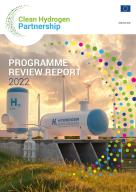Details
- Publication date
- 16 December 2022
- Author
- Clean Hydrogen Joint Undertaking
Description
Starting with 2022, the scope of the Programme Review has further broadened compared to previous years. At the core of the Programme Review remains still the Annual Programme Technical Assessment performed by the JRC; its recommendations are then complemented by the independent opinions of the wider scientific community, gathered during the EU Hydrogen Research Days as well as the input of the JU’s Stakeholders Group, on the strategic and technological priorities to be addressed by the Clean Hydrogen JU. Additionally, the Programme Review reports on relevant studies commissioned by the JU, reports published by international bodies and selected international developments, providing a more holistic picture on the wider developments in the hydrogen sector and how the Clean Hydrogen JU activities fit in this wider context.
The Programme Review covers 98 projects active between January 2021 - March 2021, which have been assigned to seven thematic pillars: Hydrogen Production, Hydrogen Storage and Distribution, Hydrogen End Uses – Transport, Hydrogen End Uses – Clean Heat and Power, Cross-Cutting Issues, Hydrogen Valleys and Hydrogen Supply Chains.
The report highlights numerous achievements of these projects in all areas of the hydrogen value chain. Significant advancements have been achieved in the electrolysers, where the best in the class have already met some of the 2024 KPIs, while demonstration projects have proven to be a reliable enable for sectorial integration. The demonstrations in fuel cell cars and buses show that they have achieved technological maturity and they are trying to find their place in the fast-evolving vehicle market looking for clean solutions. But also in terms of stationary applications, the demonstration projects have confirmed the performance of fuel cells for domestic applications. The next step for both of these end use applications is volume manufacturing of components, necessary to decrease costs further and make them more cost competitive. Finally, the JU exhibits a comprehensive portfolio of cross-cutting activities, supporting sustainability, circularity, education, public awareness, safety, PNR actions which are all essential for mass-market commercialization. The Clean Hydrogen JU needs to build on these results in the coming years, but also shift partially its Programme coverage towards areas that haven’t been explored sufficiently.
A recurring observation of stakeholders, expressed also by the wider scientific community and noted also by JRC, is the need to invest further in cross-cutting activities, in particular in relation to RCS and skills, as these tend to become the major barriers to entry in the hydrogen market. The other often identified issue is the need to ensure the availability of resources and components in EU, by strongly supporting manufacturing capacity in EU in the coming years, while also working more on materials and related sustainability aspects.
Overall, the observations and recommendations discussed in this report will provide important feedback to the Clean Hydrogen JU, in order to analyse the progress of the Programme towards achieving its objectives and adjusting it accordingly, when necessary (in particular through the next calls for proposals).

